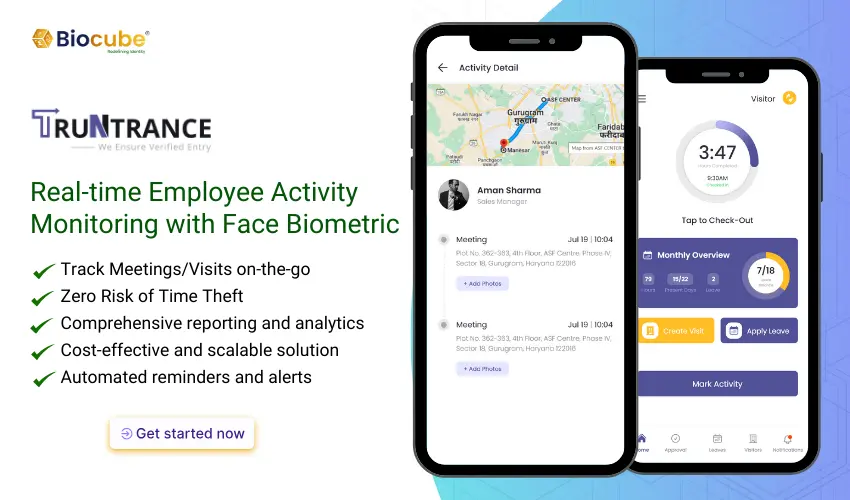
The scale of biometric time and attendance system is picking up pace. The rising requirement is due to the high demand for contactless biometric technology. According to a Statista report, the global scale of this market has already reached a whooping record of $11.98 billion and is expected to escalate to $53.15 billion by 2032.
Time and attendance systems are vital for every organization, and the use of biometric technologies in them offers a range of benefits, beginning with enhanced security and leading to higher productivity.
Table of Contents
5 Things to Know: Biometric Time and Attendance Systems

1. Assures Accuracy
It is unfortunate to see that many large and small enterprises still need to follow the traditional approach of marking attendance, such as registers and punching cards. Such systems are flawed! Why? Because they need more accuracy due to high dependency on human-driven record keeping.
Why does that matter? It does because the inaccuracy results in wrongful salary deductions spreads misinformation to the managerial heads, and creates a high demand for tickets for the admin to correct records.
How can a contactless biometric attendance system resolve this problem? Well, it requires human presence in front of a centralized device and uploads the information directly onto a dashboard. The record-keeping is accurate and readable.
Even employees who go to outdoor events use the face recognition app to mark their offsite attendance without any hassle. It results in happier employees, management, and administrators.
Read Also:
- Time Theft: How Does it Impact Your Business?
- Drastic Actions Against Employees Caught Stealing Time at Work
- TruNtrance: Employee Attendance and Activity Monitoring Solution
2. Zero-Risk of Buddy Punching
Have you heard about budding punching? It’s a buzzing scenario and a problematic issue for the HR and Admins of an enterprise. Basically, employees can mark their coworkers’ attendance on their behalf using a punching card. It allows the non-present employees to clock out early, even though they have yet to arrive on time, which means that their attendance delays go unnoticed.
According to APA, “nearly 75% of companies are losing money due to buddy punching.” Have you noticed this in your workplace? If you have, then you can put an end to it through a contactless biometric attendance system.
The best biometric attendance trackers are coupled with liveness detection, geolocation, and timestamps when marketing attendance through face, fingerprint, etc. The system makes the employees responsible for their attendance and heightens the culture of trust in the enterprise.
3. Diminishes the Risk of Contagious Diseases
The pandemic created havoc in workplaces, with enterprises taking stringent measures to avoid its rise. It remains unforgettable in the minds of the employees. The risk of catching a new infection or an existing one is still high, and the best measure is to switch to as many contactless technologies as possible.
A contactless biometric time and attendance system achieves this objective and improves the end-user experience. Moreover, people are very much familiar with face or fingerprint recognition. Therefore, it strengthens their trust in the results that it will provide.
In addition to this, contactless biometric solutions also come with temperature mapping and other health features that can be integrated as per enterprise requirements. They allow the administrators to notify the administrators of people who have a fever, cold, etc., and take measures in real-time, i.e., grant leaves, allot a designated area at the workplace, etc.
4. Assures Compliance with Labor Laws
Enterprises have to ensure that the employee’s working hours are compliant with the labour laws of the country and don’t violate the policies mentioned under any government body. Any discrepancies can result in severe problems for the enterprise.
The traditional time and attendance systems often create such a problem for startups and mid-level enterprises that still need to switch to biometric solutions. On the other hand, many large enterprises have already realized the large-scale implications of not implementing it and have taken measures to overcome them.
A contactless biometric solution certainly helps organizations at multiple scales to achieve this goal and adhere to labour laws, extending their root higher transparency and a better working environment.
5. Saves the Capital Expenditure
Inaccuracies often occur through punching cards and physical time sheets. The latter also requires maintaining a physical database at the premise to recheck records and update the systems.
Moreover, as mentioned above, time theft through punching cards, i.e., buddy hitting, is often problematic for enterprises. All these activities create a higher cost to cost compared to contactless biometric systems that frictionlessly upload accurate time records.
Paperless and cardless technology eliminates the need to go to the admin to re-issue cards. Furthermore, cards are often lost or stolen, which can cause theft within the organization and put the blame on the cardholder.
Such instances are avoided through a face recognition attendance system, and access/attendance is granted or marked in real-time. In short, the solution is not vulnerable to spoofing or tampering attempts, even those associated with physical biometrics systems.
Conclusion
Time and attendance systems play a significant role in organizations. Choosing a contactless biometric system over the traditional ones offers a range of benefits, such as higher accuracy, lower upkeep, and enhanced security.
Moreover, it lowers the workload of the administration and HR department by eliminating inaccuracies, assuring transparency, and diminishing instances of thefts or fraud. Many global organizations have already implemented such a system because it can help to avoid vast implications or tarnish brand image.
Biometrics like faces or fingerprints also create a culture of trust between employees, as it brings the aspect of familiarity into play. Lastly, in addition to this, employees can stay less worried about their discrepancies in attendance and focus more on their work, resulting in higher productivity.